
FM 21-150 COMBATIVES 1992
.pdf
FM 21-150
pass your opponent so that your right shoulder passes his right shoulder, continue moving forward about six steps, halt, and without command, execute the whirl. Remain in the attack position and wait for further commands. The command is, CROSSOVER. The instructor gives the command, and the soldiers perform the movement.
NOTE: Left-handed personnel cross left shoulder to left shoulder.
(3) Attack movements. There are four attack movements designed to disable or capture the opponent: thrust, butt stroke, slash, and smash. Each of these movements may be used for the initial attack or as a follow-up should the initial movement fail to find its mark. The soldiers learn these movements separately. They will learn to execute these movements in a swift and continuous series during subsequent training. During all training, the emphasis will be on conducting natural, balanced movements to effectively damage the target. Precise, learned movements will not be stressed.
(a) Thrust. The objective is to disable or capture an opponent by thrusting the bayonet blade into a vulnerable part of his body. The thrust is especially effective in areas where movement is restricted—for example, trenches, wooded areas, or built-up areas. It is also effective when an opponent is lying on the ground or in a fighting position. The instructor explains and demonstrates how to lunge forward on your leading foot without losing your balance (Figure 5-43, Step 1) and, at the same time, drive the bayonet with great force into any unguarded part of your opponent’s body.
To accomplish this, grasp the rifle firmly with both hands and pull the stock in close to the right hip; partially extend the left arm, guiding the point of the bayonet in the general direction of the opponent’s body (Figure 5-43, Step 2).
Quickly complete the extension of the arms and body as the leading foot strikes the ground so that the bayonet penetrates the target (Figure 5-43, Step 3).
To withdraw the bayonet, keep your feet in place, shift your body weight to the rear, and pull rearward along the same line of penetration (Figure 5-43, Step 4).
Next, assume the attack position in preparation to continue the assault (Figure 5-43, Step 5).
This movement is taught by the numbers in three phases:
1.THRUST AND HOLD, MOVE.
2.WITHDRAW AND HOLD, MOVE.
3.ATTACK POSITION, MOVE.
5-58
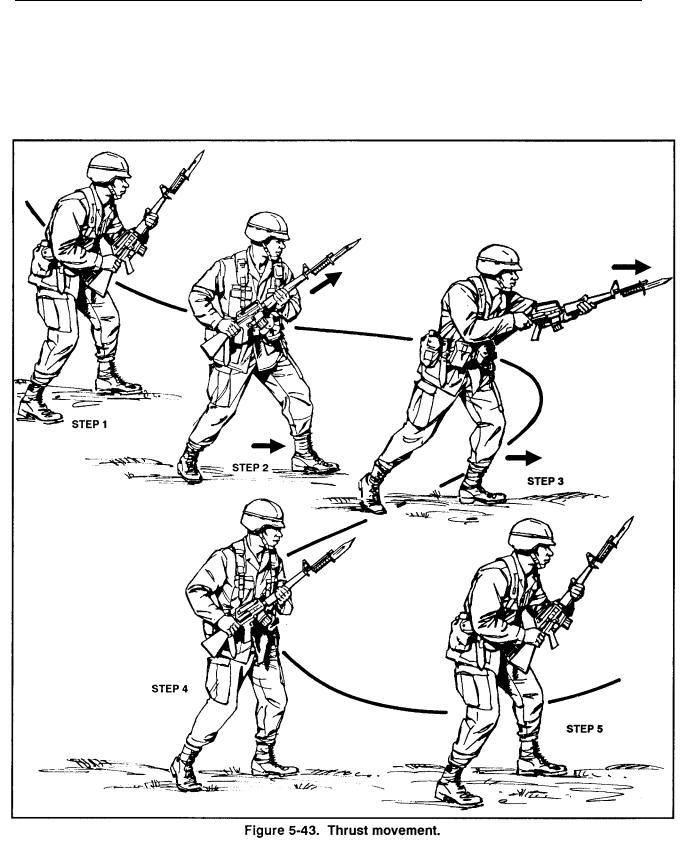
FM 21-150
At combat speed, the command is, THRUST SERIES, MOVE. Training emphasis will be placed on movement at combat speed. The instructor gives the commands, and the soldiers perform the movements.
5-59
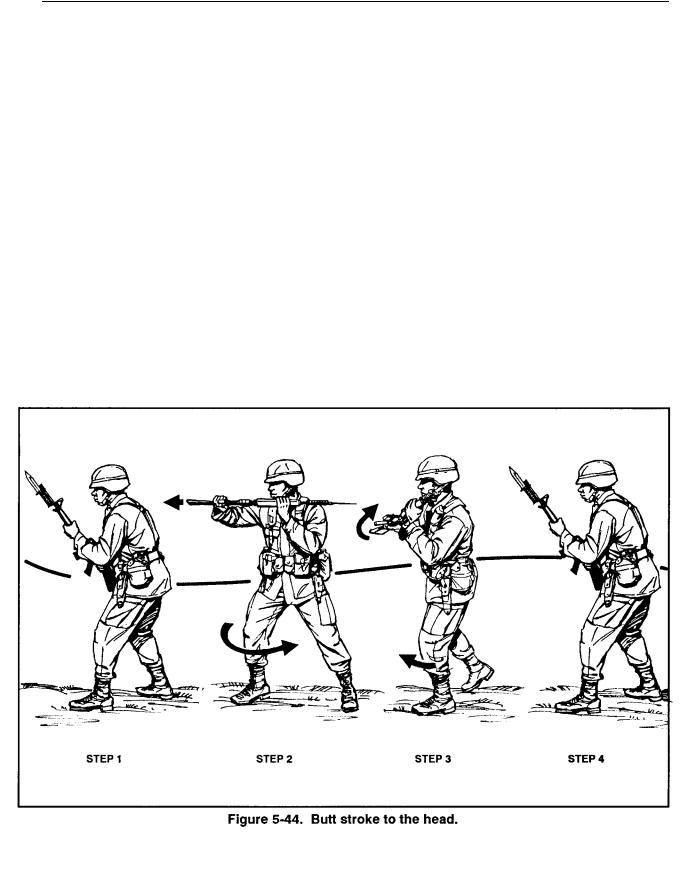
FM 21-150
(b) Butt stroke. The objective is to disable or capture an opponent by delivering a forceful blow to his body with the rifle butt (Figure 5-44, Steps 1, 2,3, and 4, and Figure 5-45, Steps 1,2,3, and 4). The aim of the butt stroke may be the opponent’s weapon or a vulnerable portion of his body. The butt stroke may be vertical, horizontal, or somewhere between the two planes. The instructor explains and demonstrates how to step forward with your trailing foot and, at the same time using your left hand as a pivot, swing the rifle in an arc and drive the rifle butt into your opponent. To recover, bring your trailing foot forward and assume the attack position. The movement is taught by the numbers in two phases:
1.BUTT STROKE TO THE (head, groin, kidney) AND HOLD, MOVE.
2.ATTACK POSITION, MOVE.
At combat speed, the command is, BUTT STROKE TO THE (head, groin, kidney) SERIES, MOVE. Training emphasis will be placed on movement at combat speed. The instructor gives the commands, and the soldiers perform the movement.
5-60
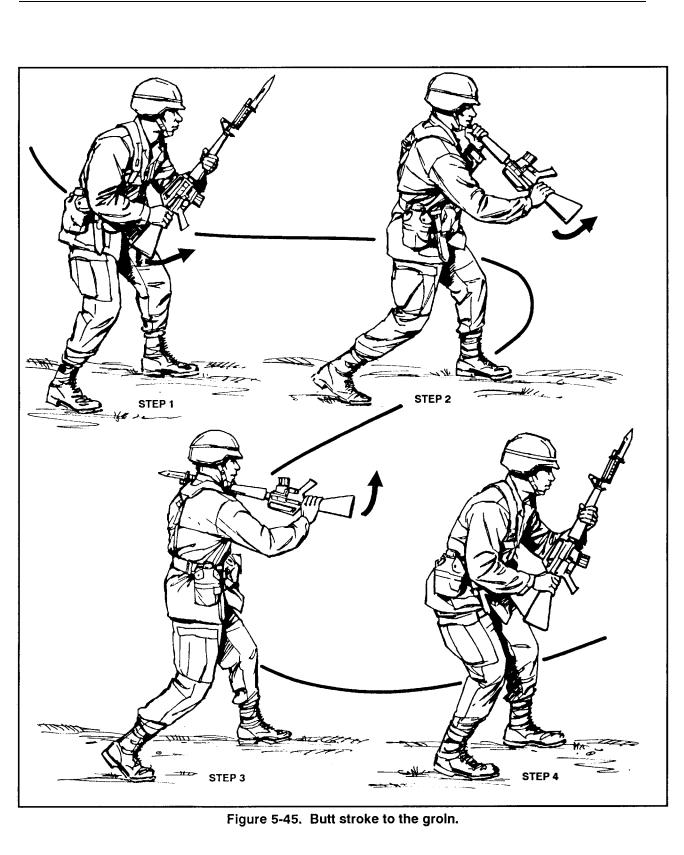
FM 21-150
5-61

FM 21-150
(c) Slash. The objective is to disable or capture the opponent by cutting him with the blade of the bayonet. The instructor explains and demonstrates how to step forward with your lead foot (Figure 5-46, Step 1).
At the same time, extend your left arm and swing the knife edge of your bayonet forward and down in a slashing arc (Figure 5-46, Steps 2 and 3).
To recover, bring your trailing foot forward and assume the attack position (Figure 5-46, Step 4).
This movement is taught by the number in two phases:
1.SLASH AND HOLD, MOVE.
2.ATTACK POSITION, MOVE.
At combat speed, the command is, SLASH SERIES, MOVE. Training emphasis will be placed on movement at combat speed. The instructor gives the commands, and the soldiers perform the movements.
5-62
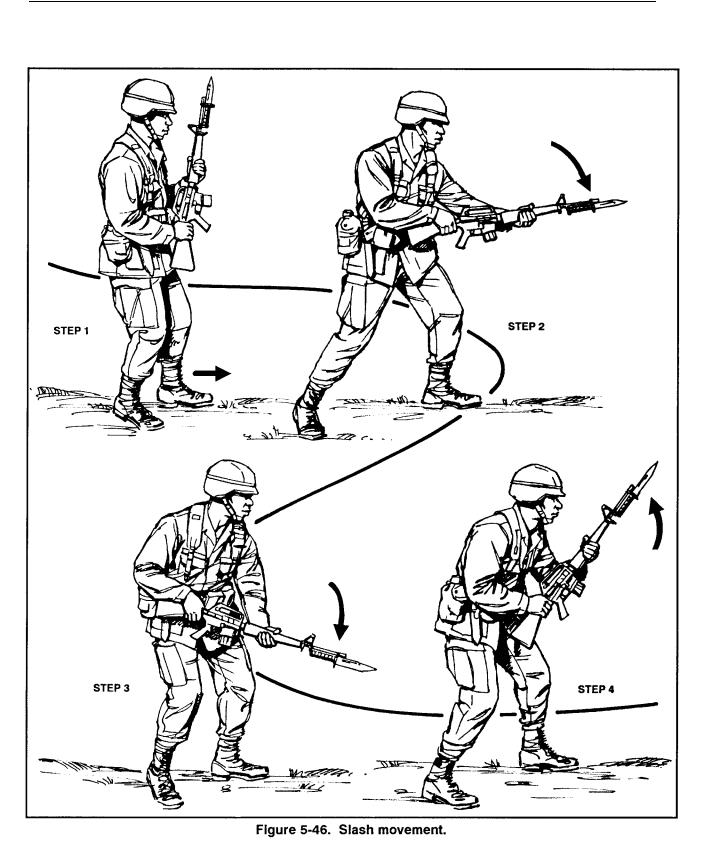
FM 21-150
5-63

FM 21-150
(d) Smash. The objective is to disable or capture an opponent by smashing the rifle butt into a vulnerable part of his body. The smash is often used as a follow-up to a butt stroke and is also effective in wooded areas and trenches when movement is restricted. The instructor explains and demonstrates how to push the butt of the rifle upward until horizontal (Figure 5-47, Step 1) and above the left shoulder with the bayonet pointing to the rear, sling up (Figure 5-47, Step 2). The weapon is almost horizontal to the ground at this time.
Step forward with the trailing foot, as in the butt stroke, and forcefully extend both arms, slamming the rifle butt into the opponent (Figure 5-47, Step 3).
To recover, bring your trailing foot forward (Figure 5-47, Step 4) and assume the attack position (Figure 5-47, Step 5).
This movement is taught by the numbers in two phases:
1.SMASH AND HOLD, MOVE.
2.ATTACK POSITION, MOVE.
At combat speed, the command is, SMASH SERIES, MOVE. Training emphasis will be placed on movement at combat speed. The instructor gives the commands, and the soldiers perform the movements.
5-64
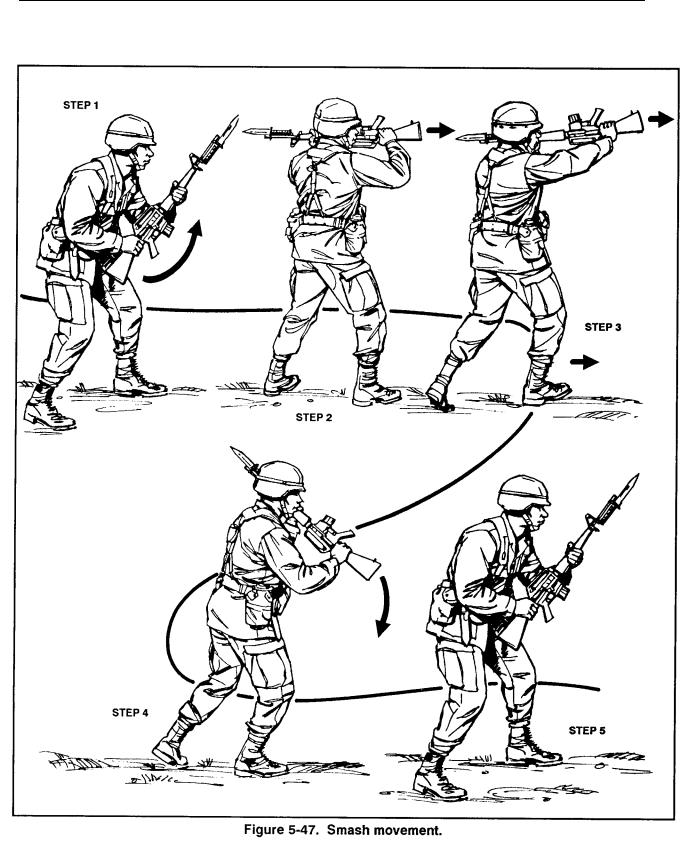
FM 21-150
5-65

FM 21-150
(4) Defensive movements. At times, the soldier may lose the initiative and be forced to defend himself. He may also meet an opponent who does not present a vulnerable area to attack. Therefore, he must make an opening by initiating a parry or block movement, then follow up with a vicious attack. The follow-up attack is immediate and violent.
CAUTION
TO MINIMIZE WEAPON DAMAGE WHILE USING BLOCKS AND
PARRIES, LIMIT WEAPON-TO-WEAPON CONTACT TO HALF
SPEED DURING TRAINING.
(a) Parry movement. The objective is to counter a thrust, throw the opponent off balance, and hit a vulnerable area of his body. Timing, speed, and judgment are essential factors in these movements. The instructor explains and demonstrates how to—
 Parry right. If your opponent carries his weapon on his left hip (left-handed), you will parry it to your right. In execution, step forward with your leading foot (Figure 5-48, Step 1), strike the opponent’s rifle (Figure 5-48, Step 2), deflecting it to your right (Figure 5-48, Step 3), and follow up with a thrust, slash, or butt stroke.
Parry right. If your opponent carries his weapon on his left hip (left-handed), you will parry it to your right. In execution, step forward with your leading foot (Figure 5-48, Step 1), strike the opponent’s rifle (Figure 5-48, Step 2), deflecting it to your right (Figure 5-48, Step 3), and follow up with a thrust, slash, or butt stroke.
5-66
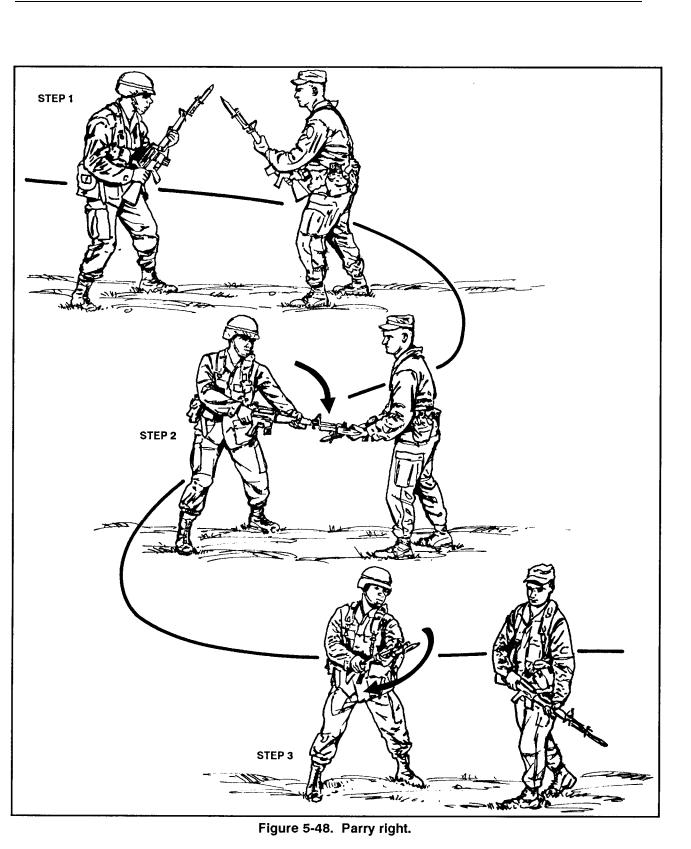
FM 21-150
5-67
